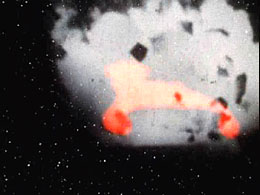Here are my calculations for the Scimitar's disruptors:
Well, phaser firepower has bugged me for a while (still does) so I tried to find examples I could use to attempt to approximate the demonstrated firepower. Oh, and 17 megatons is my
upper conservative figure-using (I think) conservative data I came up with a range from 400 KT to 17 megatons for the Scimitar's disruptors.
I first decided to use vaporization energy of iron as a standard, as I thought iron might represent the break-even point for phaser tech. That is, if phasers use a chain reaction with lighter elements "vaporised" more easily than heavy, dense, elements, iron would be the middle ground, requiring as much energy to "vaporise" as to vaporise. From the TOS episode: Day of the Dove I found a srceen shot showing the destruction of a D-7 battle cruiser, with an official mass of 120,000 tons. The Enterprise fired 4 blue phaser bursts at the powerless vessel, resulting in this:


It appears most of the vessel was "vaporized" perhaps as much as 2/3 by mass. Assuming most of the vessel is iron, I found the energy to vaporize was 144.76 KT. Divided among the 4 shots=
36.19 KT each
(2/3 of 120,000 tons=80,000 tons--8E7 kg x 7.6 MJ/kg=6.08E8 MJ-144.76 KT total 4 shots fired=36.19 KT each.)
The rate of fire is more questionable, as the blue phasers are ussually bursts, but I don't know how long each burst is. I assumed each burst was 0.5 to 0.25 seconds long and set up a range of 72.38 KT to 144.76 KT per second for each phaser emitter.
Well, this is all well and good, except ST vessels almost never do that much damage to each other-shielded or not. The best example is probably ST-TWOK, where two unshielded ships beat each other up repeatedly. Damage sustained by the E-nil appeared to be 3 to 5 cubic meters of armor "vaporized" per second-only 42.85 to 71.43 Isotons (tons of TNT-funny, isn't it?

) So, what gives? Are federation hulls that much stronger than Klingon hulls? Doubtful. Both incidents involved shieldless vessels, the only major difference was the presence of SIFs on the Enterprise. This seems like pretty good evidence for SIFs as a second line of defence, after the shields. If this is true, then the SIF of a constitution refit could offer 1013.30 to 3378.30 times the protection bare iron could provide! If this range is reliable, then it presumably could be applied to other incidents as well, such as ST-N. After loosing shields, the E-E was hit at least twice by disruptor fire, resulting in hull breaches of an unkown size. I pegged the "vaporized" area at anywhere from 6 to 12 meters accross. Obviously this makes a big difference, but without screen shots I cannot be sure. I doubt the hull is even 3 meters thick, so the shots wouldn't have "vaporized" a solid hemispere 6-12 meters accross, instead maybie as much as 50-80%, taking in to account any materials under the hull, such as bulkheads, or *possibly* the presence of a second hull. This is 28.28 to 361.91 cubic meters, 0.40 to 5.17 KT to vaporize. So, adding the SIF, I find a range of 405.32 to 17,465.81 KT. Admittidly this is a huge range, but screenshots should help clean it up. I say this is a conservative range because it ignores both the apparent presence of ablative armor on the E-E, and the likely-hood SIFs have advanced over ~100 years. In fact, shortly after the impacts, a weakening of the SIFs is reported on the bridge, lending some support to my theory. Of course, I may have phaser tech. completely off, making this overly generous, but I feel low megaton weaponry should be well within the capabilities of the federation by the time of TNG.

